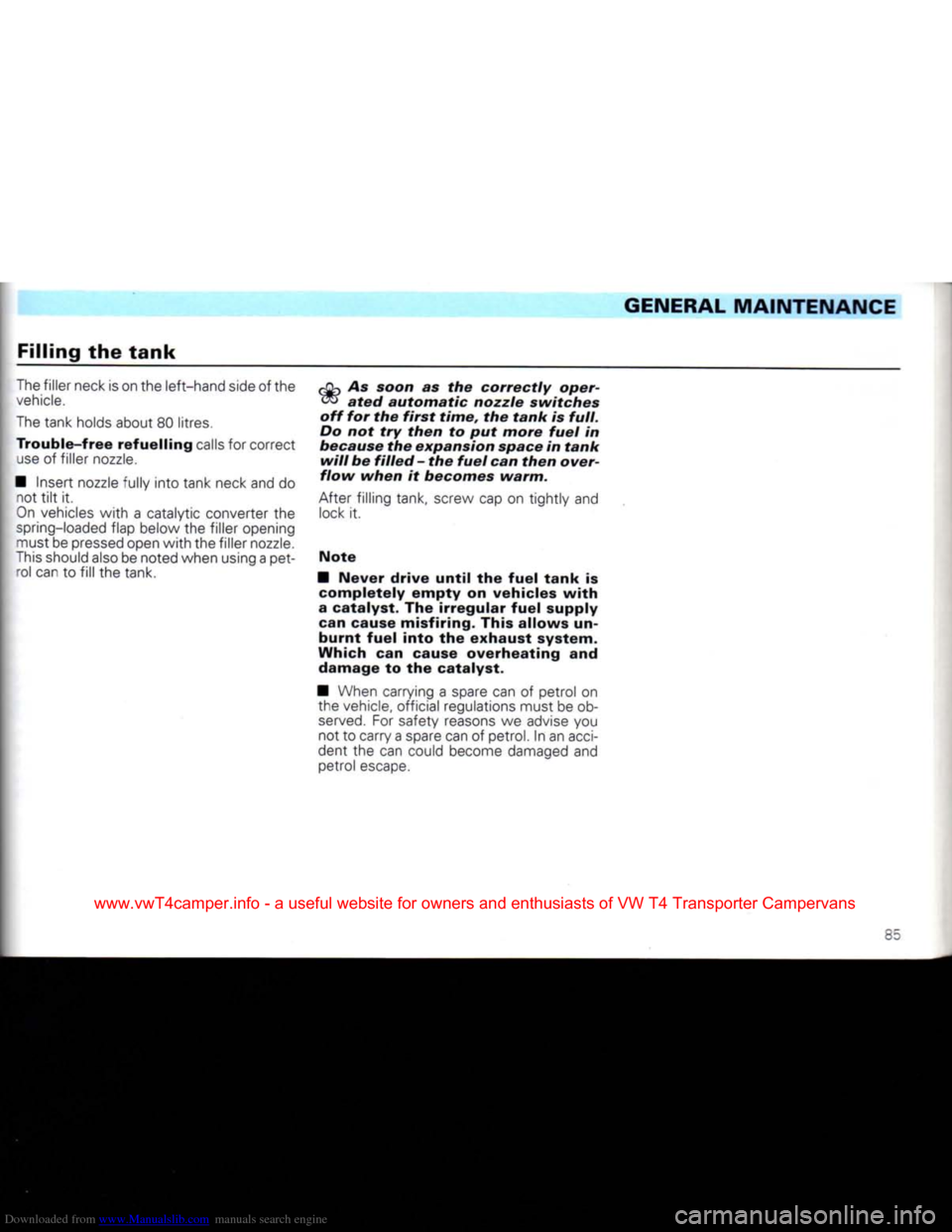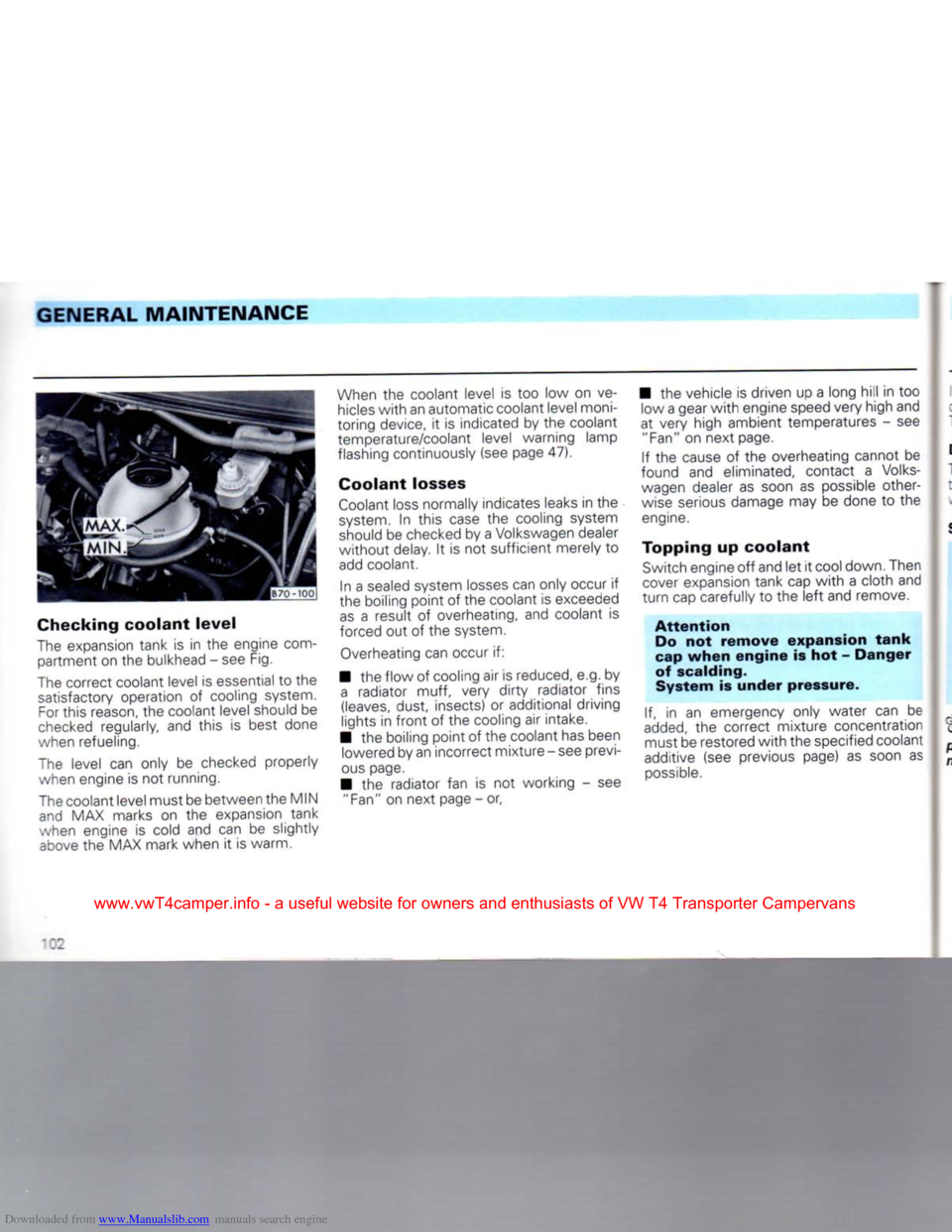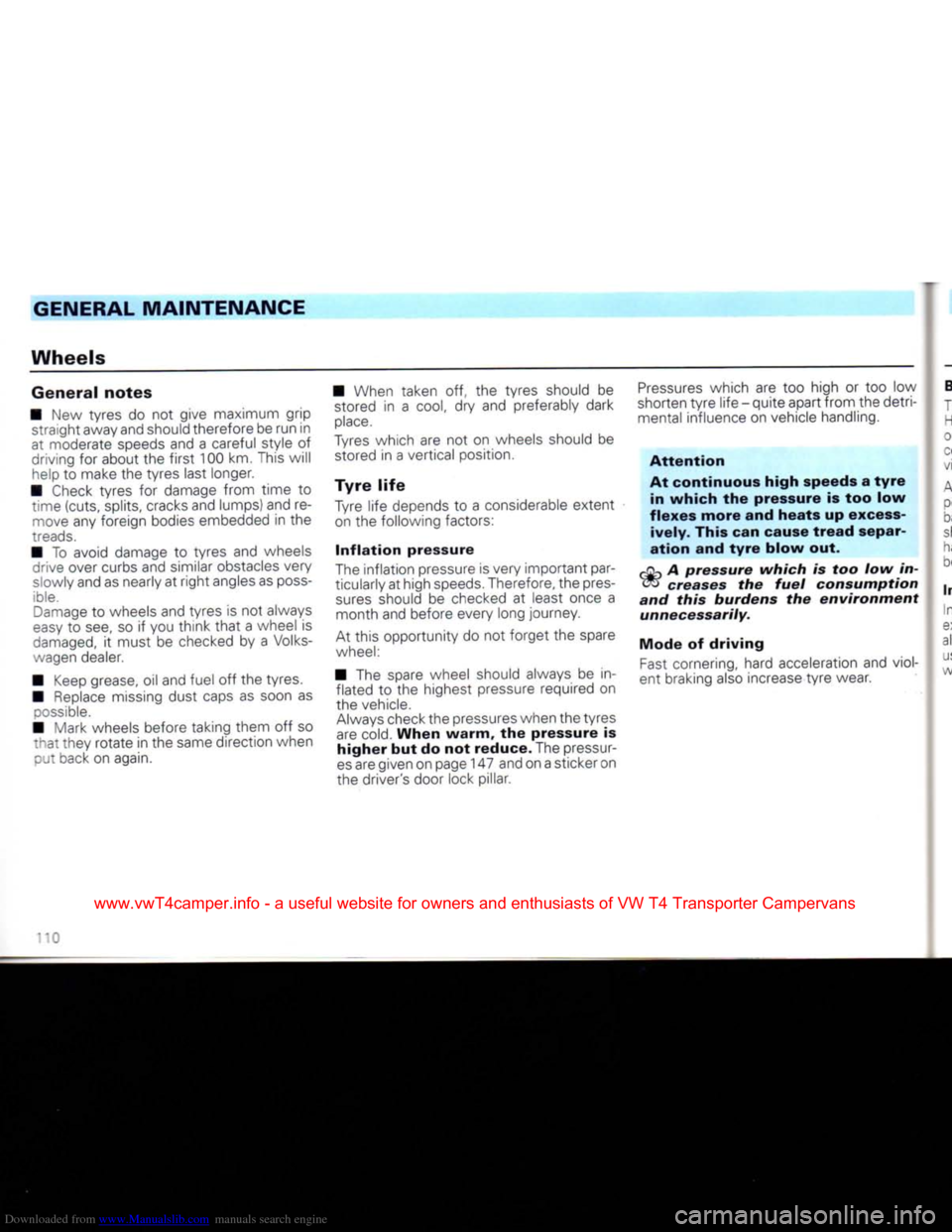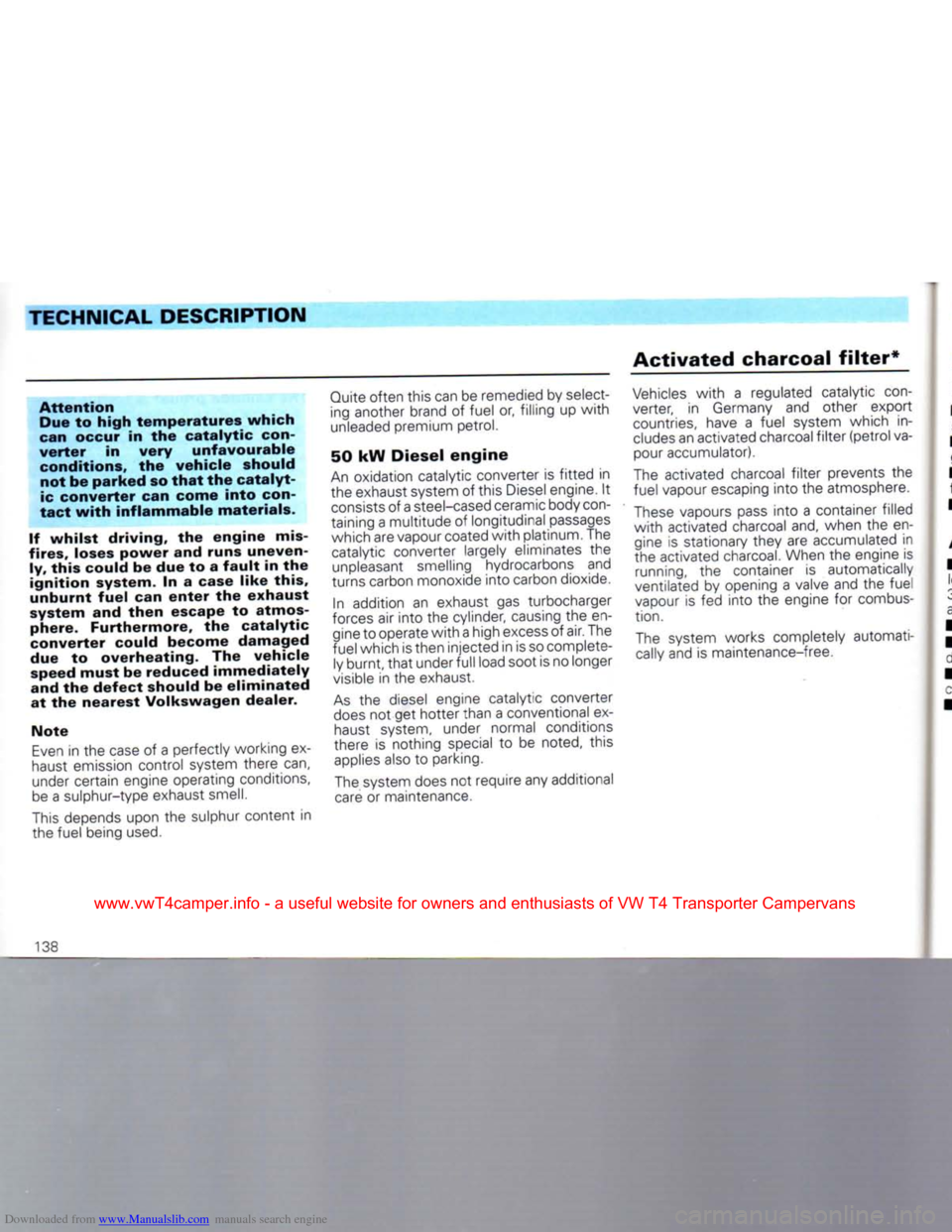1992 VOLKSWAGEN CARAVELLE fuel cap
[x] Cancel search: fuel capPage 5 of 164

Downloaded from www.Manualslib.com manuals search engine
CONTENTS
DASHBOARD AND
CONTROLS
Layout
4
i\='-:ng
lamps 6
CONTROLS
AND
EQUIPMENT
•
e.s. Central locking system 7, 8
I:cs, Tailgate 9, 10
I'I
~g doors 11
..
-^ows, Mirrors 12, 13
Sea: belts 15 5re:y for children 18
-ead restraints 19
Seats
20 _:ariing/sleeping surface 26
__ggage
compartment cover 27 __cgage compartment/load surface ... 28
-edals, Brakes 29 Vanual gearbox 31
--tomatic gearbox 32
gnition
lock 36
Starting / Stopping the engine .... 37, 38 "struments 40
.'.
arning lamps 47
Switches 50
~yn signal and dip lever 52
3'uise
control system 53 .'.'indscreen wiper 54
-eating and ventilation 55
Air
conditioner 57
Recirculating air switch 61
Auxiliary heater 63
Additional
water heater 67
Sun roof, Sliding/tilting roof 70, 71
nterior lights, Sun visors 72, 73
Ashtray, Cigarette lighter 73
-oof
rack 75
DRIVING
TIPS
The first 1500 km - and afterwards ... 76 Driving safely 78
Driving economically and
ecologically
79
Trailer towing 81
GENERAL
MAINTENANCE
Filling the tank, Fuel 85, 86
Care of car, Maintenance 88, 93 Bonnet, Engine compartment 94, 95
Engine oil, Gearbox oil 96, 99
Air
cleaner 100 Power assisted steering 100
Cooling
system 101
Brake fluid 104
Battery 106
Windscreen washer system 108
Wheels 110
Arduous operating conditions 115
Winter driving 116
Accessories, modifications and
renewal of parts 117
Mobile
telephones and two way
radios 117
DO-IT-YOURSELF
First
aid kit, Warning triangle 118
Vehicle tools 118 Spare wheel/changing wheel ... 119, 120
Fuses
122
Changing
bulbs 124
Adjusting/masking headlights .. 128,129
Headlights 129
Installing radio 129
Emergency starting 130
Tow starting/towing 132
Lifting vehicle 134
TECHNICAL
DESCRIPTION
Engine 136
Emission control system 137
Activated charcoal filter '38 Power flow '39
Steering, Axles 139 Brakes, Body -139,
1
AC
Environment compatibility 140
TECHNICAL
DATA
Engine 141
Performance 142
Fuel consumption 143
Spark plugs 145
V-belts 145
Wheels,
Tyre
pressures 146, 147
Weights,
Trailer weights 148, 151 Dimensions 152
Capacities 153
Vehicle identification data 154
SPECIAL
INFORMATION
Adjusting the brake pressure regulator 155
ALPHABETICAL
INDEX
Alphabetical index 156
CHECKS
WHEN
FILLING
THE TANK
Overview 160
3
www.vwT4camper.info - a useful website for owners and enthusiasts of VW T4 Transporter Campervans
Page 62 of 164

Downloaded from www.Manualslib.com manuals search engine
CONTROLS
AND
EQUIPMENT
Notes
Pools of
water
under
the
vehicle
• When the ambient temperature is high
and
the air very humid, condensed water
can
drip off the evaporator and form a puddle under the vehicle. This is quite nor
mal
and does not indicate a leak.
Operating
faults
• Should the air conditioner not work at
any
time, either:
- the ambient temperature is below about + 5 degrees C,
- the fuse has blown.
Check
fuse and if necessary renew it - see
page
122. If the trouble is not due to
a
defec
tive fuse, switch the system off and have it
checked.
- the air conditioner has switched off due to the coolant temperature being too high -
see
page 41
also.
• If the cooling
output
drops off, switch the
A/C
off and have the system
checked.
Using air
conditioner
economically
In cooling operation the air conditioner
com
pressor
places demands on the engine and
therefore influences the fuel consumption.
To
keep the period switched on as short as
possible,
the following points should be
noted:
• If the inside temperature is very high after the vehicle has been parked in the sun, it is recommended to open doors or win
dows
briefly to enable the hot air to
escape.
• The air conditioner should not be
switched
on during a journey if the windows
or
sliding/tilting
roof*
are open.
• If the desired interior temperature can be attained
without
switching on the air condi
tioner, the fresh air operation should be se
lected.
Recirculating
air
switch
If badly contaminated air is to be prevented
from entering the vehicle, e.g. when driving
through a tunnel, the recirculating air switch in the instrument panel can be
pressed.
When
the recirculating air system is
switched
on, a small warning lamp lights up in the switch.
However,
the recirculating air system
should
only be used for a short period other
wise
the windows will mist up.
60
www.vwT4camper.info - a useful website for owners and enthusiasts of VW T4 Transporter Campervans
Page 87 of 164

Downloaded from www.Manualslib.com manuals search engine
GENERAL
MAINTENANCE
Filling the
tank
The
filler neck is on the left-hand side of the
vehicle.
The
tank holds about 80 litres. Trouble-free
refuelling
calls
for correct
use
of filler
nozzle.
•
Insert
nozzle
fully into tank neck and do not
tilt
it.
On
vehicles with a catalytic converter the
spring-loaded
flap below the filler opening
must be
pressed
open with the filler
nozzle.
This
should
also
be noted when using a pet rol can to
fill
the tank. As soon as the
correctly
oper
ated
automatic
nozzle
switches
off for the
first
time,
the
tank
is
full.
Do not try
then
to put
more
fuel
in
because the expansion space in
tank
will
be
filled
- the
fuel
can
then
over
flow
when
it becomes
warm.
After
filling tank, screw cap on tightly and
lock
it.
Note
•
Never
drive
until
the
fuel
tank
is completely
empty
on vehicles
with
a catalyst. The
irregular
fuel
supply
can cause misfiring. This
allows
un-
burnt
fuel
into
the exhaust system.
Which can cause
overheating
and damage to the catalyst.
•
When carrying a spare can of petrol on the vehicle, official regulations must be ob
served.
For safety reasons we advise you not to carry a spare can of petrol. In an
acci
dent the can could become damaged and petrol
escape.
55
www.vwT4camper.info - a useful website for owners and enthusiasts of VW T4 Transporter Campervans
Page 104 of 164

Downloaded from www.Manualslib.com manuals search engine
GENERAL
MAINTENANCE
Checking
coolant
level
The
expansion tank
is in the
engine
com
partment on the bulkhead
-
see Fig.
The
correct coolant level
is
essential
to
the satisfactory operation
of
cooling system.
For
this reason, the coolant level should
be
checked
regularly,
and
this
is
best done
when refueling.
The
level
can
only
be
checked properly
when engine
is
not running.
The
coolant level must be between the MIN
and
MAX marks
on the
expansion tank
when engine
is
cold
and can be
slightly
above
the MAX mark when
it
is warm.
When
the
coolant level
is too low on ve
hicles
with
an automatic coolant level moni
toring device,
it is
indicated by the coolant
temperature/coolant level warning lamp
flashing continuously (see page 47).
Coolant
losses
Coolant
loss normally indicates leaks in the
system.
In
this
case
the
cooling system
should
be checked by a Volkswagen dealer
without
delay.
It is
not sufficient merely
to
add
coolant.
In
a
sealed system
losses
can only occur
if
the boiling point
of
the coolant is exceeded
as
a
result
of
overheating, and coolant
is
forced out
of
the system.
Overheating can occur
if:
• the flow
of
cooling air is reduced, e.g.
by
a
radiator
muff,
very
dirty
radiator fins
(leaves,
dust, insects)
or
additional driving
lights
in
front
of
the cooling air intake.
• the boiling point
of
the coolant has been lowered by an incorrect mixture
-
see previ
ous
page.
•
the
radiator
fan is not
working
- see
"Fan"
on next page
-
or, • the vehicle
is
driven up
a
long hill
in too
low a gear
with
engine speed very high and
at very high ambient temperatures
-
see
"Fan"
on
next page.
If
the
cause
of the
overheating cannot
be
found
and
eliminated, contact
a
Volks
wagen dealer
as
soon
as
possible other
wise
serious damage may
be
done
to the
engine.
Topping
up
coolant
Switch
engine
off
and let
it
cool down. Then
cover
expansion tank cap
with
a
cloth and
turn
cap carefully
to
the
left
and remove.
Attention
Do
not
remove
expansion
tank
cap
when
engine
is
hot
-
Danger
of scalding.
System
is
under
pressure.
If, in an
emergency only water
can be
added,
the
correct mixture concentration must be restored
with
the specified coolant
additive (see previous page)
as
soon
as
possible.
•02
www.vwT4camper.info - a useful website for owners and enthusiasts of VW T4 Transporter Campervans
Page 112 of 164

Downloaded from www.Manualslib.com manuals search engine
GENERAL
MAINTENANCE
Wheels
General
notes
• New tyres do not give maximum grip straight away and should therefore be run in
at moderate speeds and a careful style of
driving for about the
first
100 km. This will help to make the tyres last longer.
• Check tyres for damage from time to time (cuts, splits, cracks and lumps) and remove any foreign bodies embedded in the
treads.
• To avoid damage to tyres and wheels crive over curbs and similar obstacles very
slowly and as nearly at
right
angles as
poss
ible.
Damage
to wheels and tyres is not always
easy
to see, so if you
think
that
a wheel is
damaged,
it must be checked by a Volks
wagen dealer.
• Keep grease, oil and fuel off the tyres.
• Replace missing dust caps as soon as
possible.
• Mark wheels before taking them off so
that
they rotate in the same direction when put back on again. • When taken off, the tyres should be
stored in a
cool,
dry and preferably dark
place.
Tyres
which are not on wheels should be stored in a vertical position.
Tyre
life
Tyre life depends to a considerable extent on the following factors:
Inflation
pressure
The inflation pressure is very important par
ticularly at high
speeds.
Therefore, the pres
sures
should be checked at least once a month and before every long journey.
At this opportunity do not forget the spare
wheel:
• The spare wheel should always be in flated to the highest pressure required on
the vehicle.
Always
check the pressures when the tyres are cold.
When
warm,
the pressure is
higher
but do not
reduce.
The pressur
es
are given on page 147 and on a sticker on
the driver's door lock pillar.
Pressures
which are too high or too low
shorten
tyre
life - quite apart from the detri mental influence on vehicle handling.
Attention
At
continuous
high
speeds a
tyre
in
which
the pressure is too low
flexes
more
and
heats
up excess
ively.
This can cause
tread
separ
ation
and
tyre
blow
out.
pCU
A
pressure
which
is too low in- oo
creases
the
fuel
consumption
and
this
burdens
the
environment
unnecessarily.
Mode
of
driving
Fast
cornering, hard acceleration and viol
ent braking also increase
tyre
wear.
'0
www.vwT4camper.info - a useful website for owners and enthusiasts of VW T4 Transporter Campervans
Page 116 of 164

Downloaded from www.Manualslib.com manuals search engine
GENERAL
MAINTENANCE
Winter
tyres
In winter conditions winter tyres will dis
tinctly improve the vehicle's handling. This
applies
in particular to vehicles that are
equipped
with wide tyres.
Because
of their
construction (width, rubber mixture, tread
formation etc.) these tyres provide
less
trac
tion on ice and snow.
When
fitting
winter tyres note the follow
ing:
• Only radial ply winter tyres may be fitted.
The
factory recommended tyre
sizes
are
givenonpagel
46.
• To obtain the best possible handling
characteristics,
winter tyres must be
fitted
on all four wheels. • Winter tyres are no longer fully effective
when the tread has worn down to a depth
of 4 mm.
• All-weather tyres can also be used in
stead
of winter tyres.
• If you have a
flat
tyre the remarks on
using
the spare wheel on page 112 should
be
noted.
• Do not leave winter tyres
fitted
for an un
necessary
long period because when the
roads
are free of snow and ice the handling
with summer tyres is better.
For
environmental
reasons
summer
tyres
should
be
fitted
again
as soon as possible
because
normally
they
are
quieter
in
running,
tyre
wear
is
reduced
and the
fuel
consumption is
lower.
Snow chains
Snow chains may only be
fitted
on
the
front
wheels.
Snow
chains must not be
fitted
on 215/65 F
16
tyres. When
necessary
the vehicle mus:
be
equipped with smaller tyres - see
Wheels,page146.
Only
use thin chains which do not stanc
clear
more than 15 mm (including ten-
sioner).
When
using snow chains wheel
trim
plates
and
trim
rings must be taken off. For safet
reasons
the wheel bolts must then be f ittec
with caps which are available from
Volks
wagen
dealers.
When
driving over roads which are free of
snowyou
must remove the
chains.
On such
roads
they are detrimental to vehicle handl
ing,
damage the tyres and wear out quickly.
In Germany, the maximum permissible
speed
with snow chains is 50 km/h.
114
www.vwT4camper.info - a useful website for owners and enthusiasts of VW T4 Transporter Campervans
Page 138 of 164

Downloaded from www.Manualslib.com manuals search engine
TECHNICAL
DESCRIPTION
Engine
• 4 stroke petrol/Diesel engine, trans
verse
installation
• 4/5 cylinders in-line
• Cast-iron cylinder block
• 5/6 bearing crankshaft
• Sheet metal sump
• Alloy cylinder head
• Valves operated via toothed belt and overhead camshaft
• Maintenance free valve gear
with
hy draulic tappets
• Cooling system filled for life of vehicle
• Radiator
with
separate expansion tank • Electric radiator fan controlled by ther-
moswitch
• Maintenance free electronic ignition
• Long-life spark plugs
• Optical and acoustic oil pressure warn ing
• Low maintenance battery
with
high starting capacity
• Long-life low maintenance V-belts
• Thermostatically controlled intake air preheating
• Dry air cleaner
with
paper element • Fuel
injection
engines
have fully
electronic engine management (combined
control of injection and ignition systems).
• Emission control system
with
Lambda probe on petrol engines (not in all Export
markets)
•
Diesel
engines
with
distributor injec
tion
pump
with
cold start aid,
filter
preheat
ing,
self-bleeding fuel system
• Long life exhaust system.
'36
www.vwT4camper.info - a useful website for owners and enthusiasts of VW T4 Transporter Campervans
Page 140 of 164

Downloaded from www.Manualslib.com manuals search engine
TECHNICAL
DESCRIPTION
Attention
Due to high temperatures which
can occur in the catalytic
con
verter in very unfavourable conditions, the vehicle should not be parked so that the catalyt
ic converter can come into
con
tact with inflammable materials.
If whilst driving, the engine mis
fires, loses power and runs uneven ly,
this
could be due to a fault in the ignition system. In a
case
like this,
unburnt fuel can enter the exhaust
system and then escape to atmos
phere.
Furthermore, the catalytic
converter could become damaged
due to overheating. The vehicle
speed must be reduced immediately
and the defect should be eliminated
at the nearest Volkswagen dealer.
Note
Even
in the
case
of a
perfectly working
ex
haust emission control system there can, under certain engine operating conditions,
be
a
sulphur-type exhaust
smell.
This
depends upon
the
sulphur content
in
the fuel being
used.
Quite often this can
be
remedied
by
select
ing another brand
of
fuel
or,
filling
up
with
unleaded premium petrol.
50
kW
Diesel
engine
An
oxidation catalytic converter
is
fitted
in
the exhaust system
of
this Diesel engine.
It
consists
of
a steel-cased ceramic body
con
taining
a
multitude
of
longitudinal
passages
which are vapour coated
with
platinum. The catalytic converter largely eliminates
the
unpleasant smelling hydrocarbons
and
turns carbon monoxide
into
carbon dioxide.
In addition
an
exhaust
gas
turbocharger
forces
air
into
the
cylinder, causing
the
en
gine
to
operate
with
a high
excess
of
air. The
fuel which is then injected in is so complete ly
burnt,
that
under
full
load soot is no longer
visible
in the
exhaust.
As
the
diesel engine catalytic converter
does
not get
hotter than
a
conventional
ex
haust system, under normal conditions
there
is
nothing special
to be
noted, this
applies
also
to
parking.
The system does
not
require any additional
care
or
maintenance.
Activated
charcoal
filter*
Vehicles
with
a
regulated catalytic
con
verter,
in
Germany
and
other export countries, have
a
fuel system which
in
cludes
an activated charcoal
filter
(petrol vapour accumulator).
The activated charcoal
filter
prevents
the
fuel vapour escaping
into
the
atmosphere.
These
vapours
pass
into
a
container filled
with
activated charcoal and, when
the en
gine
is
stationary they
are
accumulated
in
the activated charcoal. When
the
engine
is
running,
the
container
is
automatically
ventilated
by
opening
a
valve
and the
fuel
vapour
is fed
into
the
engine
for
combus
tion.
The system works completely automati
cally
and
is
maintenance-free.
138
www.vwT4camper.info - a useful website for owners and enthusiasts of VW T4 Transporter Campervans